Introduction
Certainly we all know the
story of Moses and the Ten Commandments. He was a Hebrew child who evaded the
king of Egypt's plan to destroy all the newborn males. He was placed in a
basket
and set afloat down the river. Providentially he was found by the daughter of
Pharaoh and was raised as a son in Pharaohs household.
"And Moses was learned in all the wisdom of the Egyptians, and was mighty in
words and in deeds"
(Acts 7:22). But when Moses was
40 years of age, he saw an Egyptian smiting a Hebrew, and for this cause he
slew the
Egyptian. When Pharaoh found this out he sought after Moses to slay him,
"But
Moses fled from the face of Pharaoh, and dwelt
in the land of Midian"
(Exodus 2:15). Here Moses took the daughter of Jethro, the priest of Midian,
(descendant of Abraham, Genesis 25:1-2) and tended to his flocks for a period
of 40 years
(Acts 7:29-30).
One day
"he led the flock to the backside of the
desert, and came to
the mountain of God, even to Horeb
"
(Exodus 3:1).
It was here that the angel of the LORD appeared to Moses in a burning bush that
was not consumed and received his commission to deliver the children of Israel
out of Egypt. Moses was told
"When thou hast brought forth the people out of
Egypt,
ye shall serve God upon this mountain
"
(Exodus 3:12). This
mountain is where the children of Israel came, and there they received the
lively oracles written with the finger of God, even the Ten Commandments.
But where is this mountain? Is it in the Sinai Peninsula? Towering over
St. Catherine's Monastery? When looking in the map section of most Bibles, you
will find that the traditional Exodus route is questionable. Furthermore, all
Bible maps
will show you that the location of
Midian
is not in the Sinai Peninsula, but on the east
side of the Gulf of Aqaba in Arabia. In addition, what is traditionally known
as
Mt. Sinai down in the bottom of the Sinai Peninsula cannot be the real Mt.
Sinai
(Horeb), for the Bible clearly locates
"mount Sinai in Arabia"
(Galatians 4:25). This will be the position of this article to show
how the Bible is true in every way, and that Mt. Sinai, where the people of
Israel were to serve God, is in the ancient land of Midian, in
Arabia.
The Incredible Journey
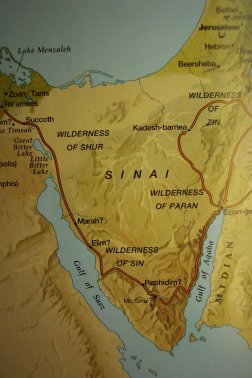
To begin this incredible journey we will first need a map. At the right, we
have a typical map that may
be found in the back of most Bibles. We shall notice that Marah,
Elim, Rephidim,
and even Mt. Sinai all have question marks behind them. Archeologically
speaking, none of these have been proven to be legitimate sites. As well, these
three places where the children of Israel encamped were all located after they
crossed the Red Sea, and you will notice that the traditional route shows no
place where they might have went through any significant amount of water, where
Pharaohs 250,000 man army might have been drowned.
When it came to pass
that Pharaoh had let Israel go
"God led them not through the way of the
land of the Philistines"
(Exodus 13:17). This was north, along the coastal
area of the Mediterranean Sea. Rather,
"God led the people about, through the
way of the wilderness of the Red sea"
(v. 18). At the northern end of the
Red Sea, it forks into the Gulf of Suez on the west, and the Gulf of Aqaba on
the east. Between these two gulfs lay the
"Wilderness of the Red Sea".
The direct southerly route, along the eastern side of the Gulf of Suez,
as it appears on the map above is certainly questionable. When Moses
fled
from Pharaoh to the land of Midian, it is highly unlikely that he would have
taken this route. There were three main ancient routes across the wilderness
from Egypt and the ruggedness of the land dictated for the most part, where
these ancient caravan routes would be. These have not changed between then and
now as can be seen on the maps below.
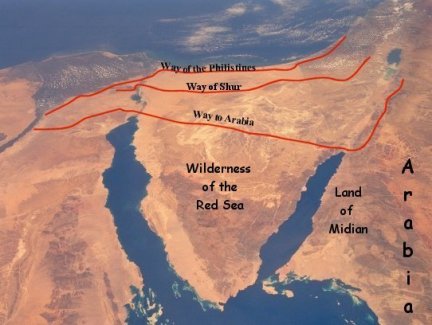
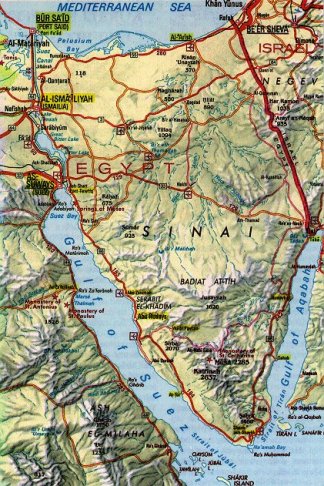
The most likely route then would have
been the "Way to Arabia", which runs along the edge of
"wilderness of the Red
Sea",
from the northern tip of the Gulf of Suez to the northern tip of the
Gulf of Aqaba, and then down into Midian on the eastern side of the Gulf of
Aqaba. This would have been the quickest and furthest place for Moses to have
fled from the hand of Pharaoh. When Moses returned to Mount Sinai with the
children of Israel, it is likely that he would
have taken the same route as when he first fled from the face of Pharaoh.
Now when the
children of Israel first left Goshen from the land of Egypt, we are told that
they
"journeyed from Rameses to Succoth"
(Exodus 12:37). Rameses could
have been one of the treasure cities mentioned in Exodus 1:11, but likely
referred to
"the land of Rameses"
(Genesis 47:11) where Goshen was
located. Now Succoth is believed to be just outside Egypt proper, which would
have been a rallying point to the North East of the Gulf of Suez where they
would have regrouped before their long trek across the wilderness.
From there
"they took their journey from Succoth, and encamped in
Etham,
in
the edge of the wilderness
"
(Exodus 13:20). This would
cover their journey from the border of Egypt across the
"wilderness of the
Red Sea"
to its edge in
"Etham"
. But where is Etham? For certain it
is
"in the edge of the wilderness".
Another clue as to its
whereabouts is when they departed
"Etham"
they made a
"turn"
and came to the place where they crossed the Red Sea.
From there they
"passed through the midst of the sea into the wilderness, and
went three days' journey in
the wilderness of Etham
, and pitched in
Marah"
(Numbers 33:8). So, they turned at Etham, they crossed the Red Sea,
and they were still in the wilderness of Etham.
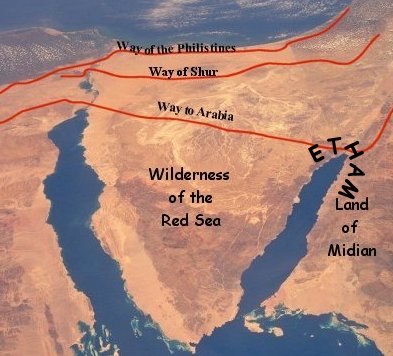
Smiths Bible Dictionary
says
Etham comes "from the Coptic
atiom
, [meaning] "boundary of
the sea,"". Perhaps then, Etham is that area known as the northern border of
the
Gulf of Aqaba, which wraps around the eastern and western coasts of the Gulf of
Aqaba. After crossing the Red Sea, this would still have placed the children of
Israel in the
"wilderness of Etham"
, which would literally be the "boundary of
the
sea".
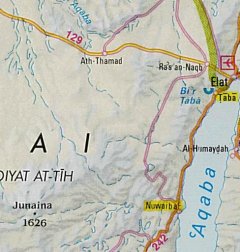
As they were encamped by the edge of the wilderness in Etham,
"the
LORD spake unto Moses, saying, Speak unto the children of Israel,
that they
turn
and encamp before Pihahiroth, between Migdol and the sea, over against
Baalzephon: before it shall ye encamp by the sea"
(Exodus 14:1-2). From the
edge of the wilderness of the Red Sea bordering Etham, the route they would
normally have taken to Midian would have been around the northern tip of the
Gulf of Aqaba and down the eastern side, but here the Lord told them to
"TURN"
(Heb. Shuwb), which means to "return" or "turn back". If we
look on a modern map (left) and see how the modern highway system goes about
the
wadis in that region, we will see that there is an abrupt turnaround at "Ra's
an-Naqb", which then proceeds south on the western side of the Gulf of Aqaba
down to a resort village called Nuwaiba.
Nuwaiba was formed as it appears
from water that has runoff through the many gorges that converge and drain the
Sinai Peninsula on the northeastern side into the Gulf of Aqaba. The silt has
formed an area of several square miles and would be more than sufficient to
hold
several million of the children of Israel who would encamp there by the sea.
The
location described in the Bible appears to fit the characteristics of Nuwaiba.
This spot on the sea was before
"Pihahiroth"
. When we look up this name in
the Strong's Concordance, we find the definition "mouth of the
gorges".
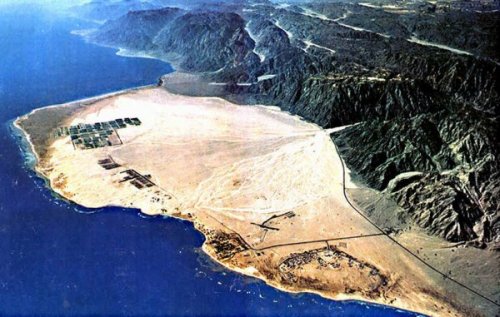
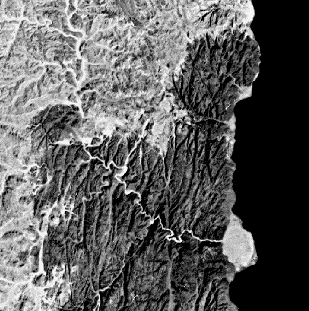
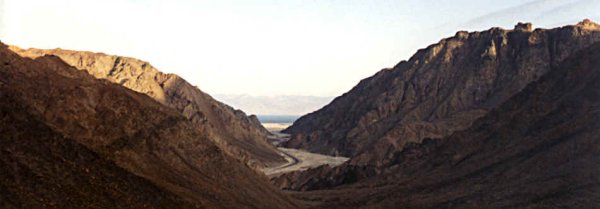
On the picture to the left, you can see Nuwaiba through the mouth of
the gorge. Today, a highway traverses this gorge, which is known as Wadi Watir,
which leads down to Nuwaiba that is today turned into a tourist attraction.
From the satellite photo above and the aerial photo (above left), we can see
how the
children
of Israel would have no place to escape from Pharaohs army. Pharaoh said,
"They are entangled in the land, the wilderness hath shut them in"
(Exodus 14:3). Josephus recorded this event saying that the Hebrews were driven
into "a narrow place", and that they were shut "up between inaccessible
precipices and the sea; for there was on each side a ridge of mountains that
terminated at the sea, which were impassable by reason of their roughness"
(Antiquities of the Jews, Book 2, Chapter 15).
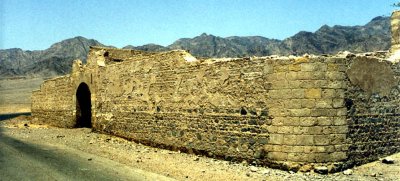
The place where the
children of Israel encamped was also described as
"between Migdol and the
sea".
The word Migdol in the Hebrew means fortress or tower. Perhaps this
could refer to the rugged mountains all around this location making it as it
were, a fortress of sorts. Smith's Bible Dictionary, under "Migdol" states, "A
native etymology has been suggested, giving the signification "multitude of
hills"". If this satisfies not the reader, just to the north of the Hebrew
encampment lays an ancient fortress pictured here, which may be referred to as
Baalzephon
(Hebrew: Lord of the North). This is supposedly of Egyptian
making.
God's Mighty Hand of Deliverance
With the
children of Israel now entangled in the land, and the wilderness shutting them
in, they now had the sea before them, and Pharaoh's 250,000-man army behind
them. In desperation the children of Israel began to cry to Moses saying,
"Because there were no graves in Egypt, hast thou taken us away to die in the
wilderness? wherefore hast thou dealt thus with us, to carry us forth out of
Egypt? Is not this the word that we did tell thee in Egypt, saying, Let us
alone, that we may serve the Egyptians? For it had been better for us to serve
the Egyptians, than that we should die in the wilderness"
(Exodus 14:11-12).
"And Moses said unto the people,
Fear ye not, stand still, and see the
salvation of the LORD
, which he will shew to you to day: for the Egyptians
whom ye have seen to day, ye shall see them again no more for ever. The LORD
shall fight for you, and ye shall hold your peace"
(v. 13-14).
This
point brings us to one of the most spectacular of miracles of the Old Testament
when God parted the waters of the Red Sea,
"and the waters were a wall unto them
on their right hand, and on their left"
(v. 22) that the children of Israel
might cross on dry ground. The Bible tells us that the Egyptians pursued Israel
into the midst of the sea, but the Lord confounded them and
"took off
their chariot wheels"
(v. 25) and the Lord caused the waters to return
"and covered the chariots, and the horsemen, and all the host of Pharaoh that
came into the sea after them; there remained not so much as one of them"
(v. 28).
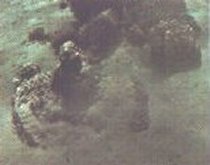
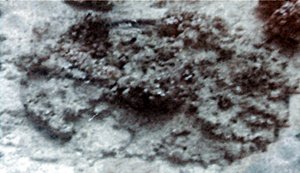
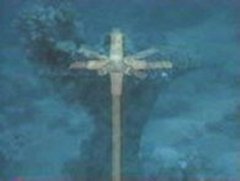
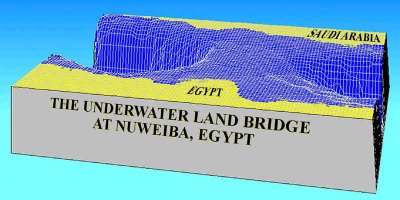
There have been various groups who have been trying to determine if
this indeed could have been the exact place that the Hebrews crossed the Red
Sea. In all of the Gulf of Aqaba, this would have been the only probable
location that they might have crossed for there is a natural (supernatural)
land
bridge between the Sinai and Arabian peninsulas, under the water. As well,
there
are very interesting, and strange coral formations found there that are not
found anywhere else in the Gulf of Aqaba that may be the remnants of
Pharaohs chariots. As one diver observed, it looked like a junkyard with debris
strewn throughout the sandy bottom. It should be noted that coral needs
something that it can form on and will not stick to sand. This might suggest
that at one time or another there has been something deposited on the sandy
bottom for the coral to start forming there.
So Great a Salvation
When the Israelites crossed
over the Red Sea and saw the Egyptians dead upon the seashore, the people
feared
the LORD, and believed the LORD. The children of Israel then rejoiced and
lifted
up their voice and sang
"The LORD is my strength and song,
and he is
become my salvation
: he is my God, and I will prepare him an habitation; my
father's God, and I will exalt him"
(Exodus 15:2). A literal translation of
this verse reads,
"The LORD is my strength and song,
Yeshua
:
he is
my God
, and I will prepare him an habitation; my father's God, and I will
exalt him".
It was there they proclaimed that Jesus (Yeshua) was
their God. The name Jesus means Salvation. The angel Gabriel told Joseph
"and
thou shalt call his name
JESUS: for he shall
save
his people from
their sins"
(Matthew 1:21).
We need not wonder if this was really
Jesus in the wilderness for we are told in the New Testament,
"that spiritual
Rock that followed them … was Christ"
(1Corinthians 10:4). Stephen testified
the same saying
"This is he that was in the church in the wilderness with the
angel which spake to
[Moses]
in the mount Sinai"
(Acts
738).
The Lord had redeemed them from the terrible hand of Pharaoh and
delivered them from the bondage of Egypt. They were the people that God had
"purchased"
(Exodus 15:16), and the fame of this great deliverance was
spread all the way to Canaan where they
"heard how the LORD dried up the
water of the Red sea for you, when ye came out of Egypt"
(Joshua 2:10).
Because of this, some believed and confessed
"the LORD your God, he is God in
heaven above, and in earth beneath"
(v. 11), even Rahab the harlot who
sought mercy from the Lord and was delivered from destruction. The Philistines
had heard as well what happened to the Egyptians and were sore afraid when the
Israelites were come nigh unto them saying
"Woe unto us! who shall deliver us
out of the hand of these mighty Gods? these are the Gods that smote the
Egyptians with all the plagues in the wilderness"
(1Samuel
4:8).
"So Moses brought Israel from the Red sea, and they went out
into the wilderness of Shur; and they went three days in the wilderness, and
found no water"
(Exodus 15:22). The
"wilderness of Shur"
is called
"the wilderness of
Etham"
in Numbers 33:8, and they pitched there in Marah. From Marah they
removed and
"came to Elim, where were twelve wells of water, and threescore
and ten palm trees: and they encamped there by the waters"
(v. 27). Some
have placed Elim in the modern township of
Al Bad,
where there are palm trees
and several springs to be found.
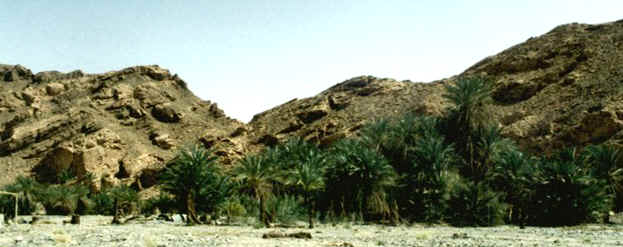
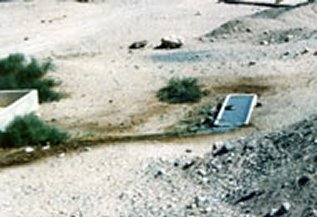
"And they removed from Elim, and
encamped by the Red sea"
(Numbers 33:10).
"And they removed from the Red
sea"
(v. 11),
"and all the congregation of the children of Israel came
unto the wilderness of Sin, which is between Elim and Sinai, on the fifteenth
day of the second month after their departing out of the land of Egypt"
(Exodus 16:1). It was thirty days earlier, on the eve of the Passover that they
went out of Egypt in haste. From Egypt they traveled over 300 miles, which
would
have been an average of 10 miles per day.
It would be yet another 16
days before they would come to the mount of God (Exodus 19:1-2). Their path
would take them out of the wilderness of Sin to Dophkah, then to Alush, then
Rephidim which was to the west of Mt. Sinai, and finally to the wilderness of
Sinai where was the mountain of God (Numbers 33:9-15). Due to the closed doors
of the Saudi Arabian government to foreigners, it has made it difficult in
locating
some of these places. However, there have been a few who have obtained work
visas or who have gained entrance otherwise and have made some amazing
discoveries.
Split Rock at Rephidim
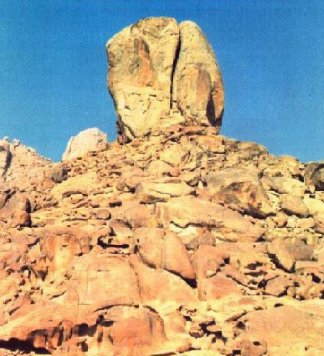
When the children of Israel
arrived at Rephidim there was no water for the people to drink. Here was yet
another amazing sign and wonder as to how God provided for Israel
supernaturally in
the wilderness. God had already turned the bitter waters of Marah sweet and
provided satisfaction for them with 12 springs at Elim. When they hungered He
rained feathered fowls for them to eat and bread from heaven. But now they had
come to Rephidim. Here Israel found no oasis or water to drink and they began
to
murmur and strive against Moses.
They
"believed not in God, and
trusted not in his salvation"
(Psalm 78:22). They sinned and provoked the
most High in the wilderness, and tempted Him. They remembered not his hand, nor
the day when He delivered them from the enemy. Their heart was not right with
Him, neither were they steadfast in His covenant. Therefore was the Lord wroth
and a fire was kindled against Jacob and his anger against Israel. Every
transgression was to receive a just recompense of reward. But it was here that
God said
"Behold, I will stand before thee there upon
the rock in
Horeb
; and thou shalt smite the rock, and there shall come water out of it,
that the people may drink. And Moses did so in the sight of the elders of
Israel"
(Exodus 17:6).
What a wonderful picture we have here of the grace and mercy of our
great God poured out for sinners.
"But he, being full of compassion, forgave
their iniquity, and destroyed them not: yea, many a time turned he his anger
away, and did not stir up all his wrath"
(Psalm 78:38).
"It is of the
LORD'S mercies that we are not consumed, because his compassions fail not"
(Lamentations 3:22). How often did they provoke Him, and grieve Him in the
desert, but one day Jacob shall recognize the One whom they have forsaken and
they shall look upon Him whom they
have pierced and then shall they drink of that
"fountain opened … for sin and for
uncleaness"
(Zechariah 13:1), and they shall see Jesus who was
smitten of God, and bruised for our iniquities.
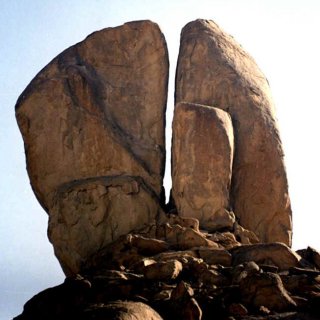
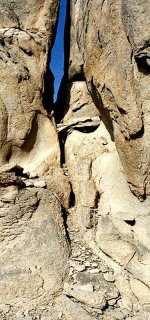
Now, on the backside of
Mount Sinai, there is a very peculiar looking rock, 60 feet tall that is split
down the middle. When closely examined, one can see that the base and the
surrounding area has the appearance of water erosion. From the cleft in the
rock
and downhill, the sediment is washed away and the rocks are very
smooth. Is this not what is recorded for us in the Scriptures?
"He clave the rocks in the wilderness, and gave them drink as
out of the great depths. He brought streams also out of the rock, and caused
waters to run down like rivers … he smote the rock, that the waters gushed out,
and the streams overflowed"
(Psalm 78:15-16, 20).
"And they thirsted not
when he led them through the deserts: he caused the waters to flow out of the
rock for them: he clave the rock also, and the waters gushed out"
(Isaiah
48:21).
"He opened the rock, and the waters gushed out; they ran in the dry
places like a river"
(Psalm 105:41).
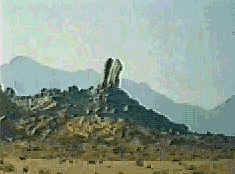
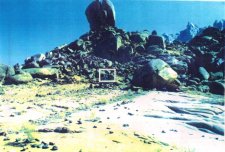
This miraculous provision of our
Creator and Lord Jesus illustrates that He is the giver and sustainer of life
for without water they would surely have perished in the wilderness. He is
"the fountain of living waters"
(Jeremiah 2:13) and can give
"thee
living water"
(John 4:10) whereby ye
"shall never thirst"
(v. 14).
But one must come by faith. Jesus said,
"he that believeth on me shall never
thirst"
(John 6:35). And in those who come to Christ is promised a
"well of
water springing up into everlasting life"
(John 4:14).
Are you
thirsty? Are you tired of drinking that which satisfies not? Jesus said,
"If
any man thirst let him come unto me, and drink. He that believeth on me, as the
scripture hath said, out of his belly shall flow rivers of living water"
(John 7:38-39). For those who will receive Jesus as Lord and Savior, He
promises,
"I will come in to him"
(Revelation 3:20). Only He can satisfy
our every need above all that we ask or think. He says,
"I will give unto him
that is thirsty of the fountain of life freely"
(Revelation 21:6).
"How
excellent is thy lovingkindness, O God! therefore the children of men put their
trust under the shadow of thy wings. They shall be abundantly satisfied with
the
fatness of thy house; and thou shalt make them drink of the river of thy
pleasures. For with thee is the fountain of life: in thy light shall we see
light"
(Psalm 36:7-9).
Mount Sinai in Arabia
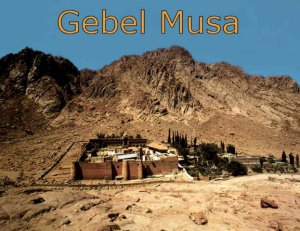
The Lord told Moses
"When
thou hast brought forth the people out of Egypt, ye shall serve God upon this
mountain"
(Exodus 3:12), but where is this mountain? As we have discussed,
Moses had escaped the hand of Pharaoh into the land of Midian, which is on the
eastern side of the Gulf of Aqaba. And if there is any uncertainty as to it's
location we need only listen to Paul who locates
"mount Sinai
in
Arabia"
(Galatians 4:25).
We have looked at the rock that the Lord
opened for the thirsty Israelites, and should notice that the Lord calls it
"the rock in Horeb"
(Exodus 17:6). This is an important clue when trying
to locate the real Mount Sinai. And for the record, this rock is located on the
backside of the mountain that is believed to be the real Mount Sinai in Arabia.
The traditional Mount Sinai (Gebel Musa) is located in the Sinai Peninsula
where
St. Catherine's Monastery is located, but archeologically there is no evidence
to support this claim by the monks who have lived at its base since the third
or
fourth century.
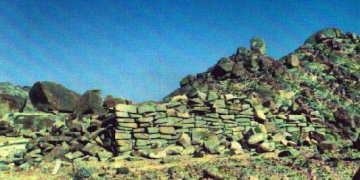
Thus far, the children of Israel had come to Rephidim
where the Lord had graciously given them water out of a rock. But Israel chided
against the Lord saying
"Is the LORD among us, or not? Then came Amalek, and
fought with Israel"
(Exodus 17:7-8). As it turned out, Israel defeated
Amalek and
"Moses built an altar, and called the name of it
Jehovah-nissi"
(v.15), "The LORD is my banner", to commemorate the victory
over the Amalekites.
So, not only should there be a split rock in the
vicinity of Rephidim, but close by the rock in Horeb, there should also be an
altar. Perhaps the altar in the adjacent picture, located about 200 yards from
the
"rock in Horeb"
is that altar.
From here the children of
Israel left Rephidim and camped before the mountain of God (Exodus 19:1-2).
They
arrived there in the third month on the first day, making their journey a total
of 46 days. Israel was to wash their clothes and to sanctify themselves that
they might be ready against the third day, for on the third day the Lord was
going
to come down in the sight of all the people upon Mount Sinai.
On the
third day, the Lord descended upon the top of the mount and called Moses up to
receive the words of the covenant.
"And Moses came and told the people all
the words of the LORD, and all the judgments: and all the people answered with
one voice, and said, All the words which the LORD hath said will we do"
(Exodus 24:3). And Moses wrote these words in the
"the book of the
covenant"
(v. 4, 7) and on the next morning he built another
altar
at
the bottom of the hill and set up
12 pillars
according to the twelve
tribes of Israel. The children of Israel then made sacrifice and Moses
sprinkled
half the blood on the altar and kept the other half in basins.
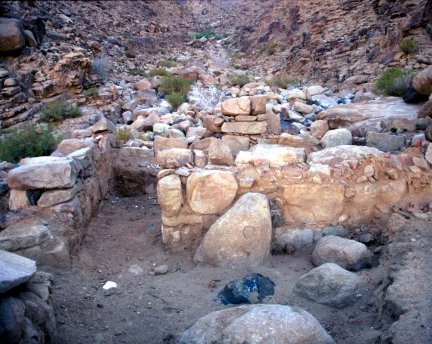
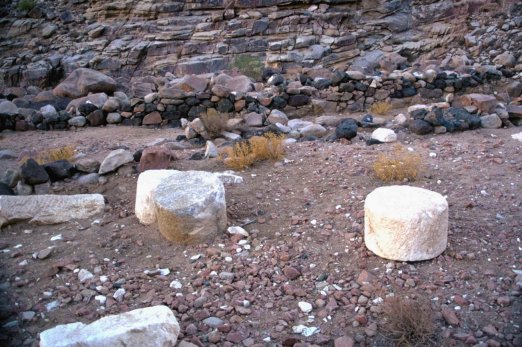
He then
took the book of the covenant and read it to them again, and for the third time
Israel said
"All that the LORD hath said will we do, and be obedient".
Moses then took the blood and sprinkled it upon the people and upon the book of
the covenant, sealing the covenant made with the Lord concerning all that was
written in the book.
It should be noted, that from the time that Israel departed out of Egypt
unto the giving of the Law (first covenant) was 50 days. This was commemorated
annually at the feast of Pentecost (Leviticus 23:15-16), which was also the
self
same day when the Holy Spirit was sent giving birth to the church (Acts
2:1-4).
Now, this mountain in Arabia is called Jabal al Lawz, and is the
highest mountain in the region. It stands at 2575 meters, which is 295 meters
taller than the traditional Mt. Sinai (Gebel Musa) in the Sinai Peninsula. This
mountain in Arabia stands out from the rest of those surrounding it in that its
mountain peak is black.

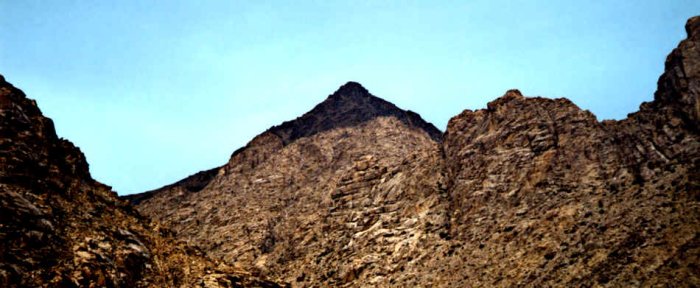
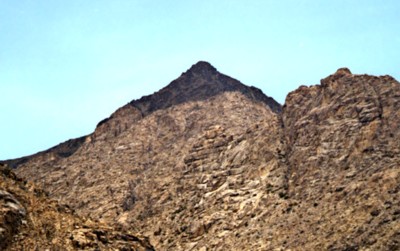
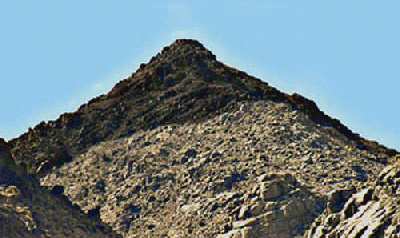
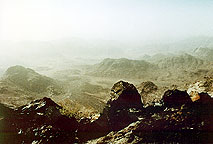
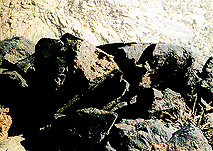
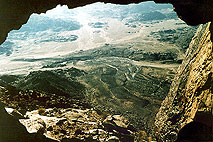
Also, upon this mount is a cave that perhaps was the one where Elijah found
shelter (1Kings 19:7-9)(above, left). Eyewitness accounts have claimed that the
blackened top is not volcanic in substance, but the rock is a granite material
that has the appearance of having been scorched. This is exactly what the Bible
says happened. The
LORD came down upon Mount Sinai, on the top of the
mount, and the mountain burned with fire.
"And mount Sinai was altogether on
a smoke, because
the LORD descended upon it in fire
: and the smoke
thereof ascended as the smoke of a furnace, and the whole mount quaked
greatly…And the LORD came down upon mount Sinai,
on the top of the
mount
"
(Exodus 19:18, 20).
"The
mountains melted
from before
the LORD, even that Sinai from before the LORD God of Israel"
(Judges 5:5).
"And ye came near and stood under the mountain; and
the mountain burned
with fire
unto the midst of heaven, with darkness, clouds, and thick
darkness. And the LORD spake unto you out of the midst of the fire"
(Deuteronomy 4:11-12).
"And the sight of the glory of the LORD was
like devouring fire on the top of the mount
in the eyes of the children
of Israel"
(Exodus 24:17).
Moses now went up again into the mount,
this time to receive the lively oracles written with the finger of God, even
the
tablets of stone, and to receive instructions for the building of the
tabernacle
that the Lord might dwell among His people. Moses was upon the mount for forty
days and nights (Exodus 24:18), and when the people saw that Moses delayed to
come down they built a golden calf, and said,
"These be thy gods, O Israel,
which brought thee up out of the land of Egypt. And when Aaron saw it, he built
an altar before it"
(Exodus 32:4-5).
Before Mount Sinai, there is a
very peculiar mound of rocks with engravings or petroglyphs of cattle. This is
quite peculiar indeed considering its location in the middle of the desert.
This
is indeed another evidence of perhaps the true location of Mount Sinai. The
Saudi government does not want any disclosure of this place and has set up a
fence around the mountain with a guardhouse to watch for
trespassers.
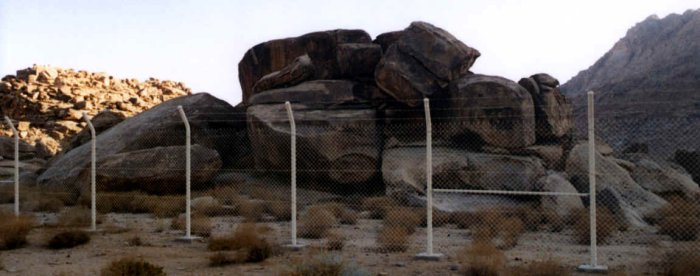
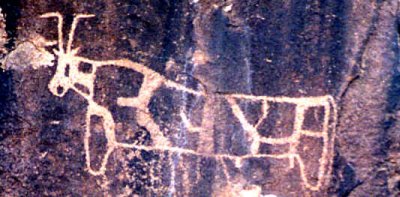
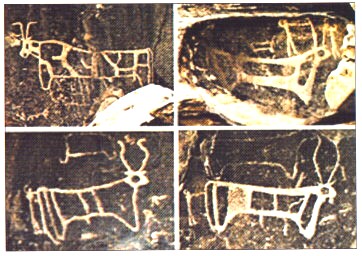
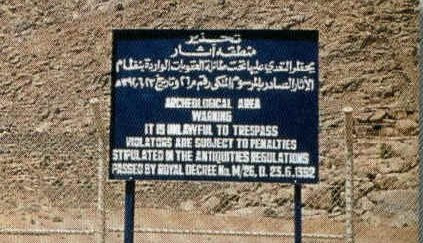
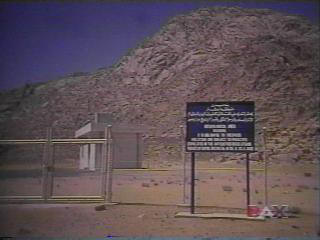
Whether it can be proven beyond a shadow of a doubt, that
Jabal al Lawz is the real Mount Sinai, may not be of real importance.
What is important are the lessons to be learnt along the way. The Apostle Paul
wrote,
"Now these things were our examples, to the intent we should not lust
after evil things, as they also lusted. Neither be ye idolaters, as were some
of
them; as it is written, The people sat down to eat and drink, and rose up to
play. Neither let us commit fornication, as some of them committed, and fell in
one day three and twenty thousand. Neither let us tempt Christ, as some of them
also tempted, and were destroyed of serpents. Neither murmur ye, as some of
them
also murmured, and were destroyed of the destroyer. Now all these things
happened unto them for ensamples: and they are written for our admonition, upon
whom the ends of the world are come. Wherefore let him that thinketh he
standeth
take heed lest he fall"
(1Corinthians 10:6-12).
These things happened
to the children of Israel and are to be examples for us. Paul wrote to the
church at Rome saying,
"For whatsoever things were written aforetime were
written for our learning, that we through patience and comfort of the
scriptures
might have hope"
(Romans 15:4).
The Bread of God
A final lesson might be learned as
we bring to a close this article. Many miracles were wrought before the
children
of Israel in their wilderness wanderings, yet it did not help them to believe.
Miracles as an act of God always had some great purpose behind it, and were to
teach
some lesson. When the children of Israel hungered God provided manna 40 years
in
the wilderness. Moses said,
"This is the bread which the LORD hath given you
to eat"
(Exodus 16:15). Paul said, all did
"eat the same spiritual
meat"
(1Corinthians 10:3), but this manna was real physical food to nourish
their bodies. God did provide them manna to meet their physical needs, but some
did learn
"that man doth not live by bread only, but by every word that
proceedeth out of the mouth of the LORD"
(Deuteronomy 8:3).
How often
Israel was charged,
"All the commandments which I command thee this day shall
ye observe to do, that ye may live"
(Deuteronomy 8:1). Likewise, they would
perish if they
"would not be obedient unto the voice of the LORD your
God"
(v. 20). God had given them words to live by but they had
"an evil
heart of unbelief"
(Hebrews 3:12). They heard the gospel just as we
"but
the word preached did not profit them, not being mixed with faith in them that
heard it"
(Hebrews 4:2). If they truly believed the Word of God, they would
have hearkened unto the Lord. A living faith is always coupled with repentance
(Luke 13:3) and works (James 2:14, 24, 26). Paul
said
"the righteousness of God
[is]
revealed from faith to faith: as
it is written, The just shall live by faith"
(Romans 1:17).
When
Jesus was challenged to perform a miracle by His unbelieving disciples, to
produce bread from heaven as their fathers ate in the wilderness, Jesus
replied,
"the bread of God is He which cometh down from heaven, and giveth life unto
the world … I am the bread of life: he that cometh to me shall never hunger;
and
he that believeth on me shall never thirst"
(John 6:33, 35).
The
Lord not only claimed to have sent the Bread, but also claimed to be that Bread
sent from heaven. Jesus said,
"I am that bread of life. Your fathers did eat
manna in the wilderness, and are dead. This is the bread which cometh down from
heaven, that a man may eat thereof, and not die. I am the living bread which
came down from heaven: if any man eat of this bread, he shall live for ever:
and
the bread that I will give is my flesh, which I will give for the life of the
world"
(John 6:48-51).
How then can we eat such
"living bread"
as this? Not as the children of Israel ate manna in the wilderness and are
dead,
but this bread whereby we shall live forever? Jesus said,
"It is the spirit
that quickeneth
(gives life)
…the words that I speak unto you, they are
spirit, and they are life"
(John 6:63). Jesus is the Word of God (John 1:1), He is the
"Word of Life"
(1John 1:1),
and He has given us His Word:
"Verily, verily, I say unto you, He that
believeth on me hath everlasting life"
(John 6:47).
The Word of God
is more than our
"necessary food"
(Job 23:12). How many of the saints
have been filled and satisfied therewith.
"Thy words were found, and I did
eat them; and thy word was unto me the joy and rejoicing of mine heart"
(Jeremiah 15:16).
"How sweet are thy words unto my taste! Yea, sweeter than
honey to my mouth!"
(Psalm 119:103). Have you had your portion today?
"The gospel of Christ … is the power of God unto salvation to everyone that
believeth"
(Romans 1:16).
"Christ died for our sins according to the
scriptures … he was buried, and … he rose again the third day according to the
scriptures"
(1Corinthians 15:3-4). This is
"the gospel … by which also ye
are saved … unless ye have believed in vain"
(v. 1-2).

 To begin this incredible journey we will first need a map. At the right, we
have a typical map that may
be found in the back of most Bibles. We shall notice that Marah,
Elim, Rephidim,
and even Mt. Sinai all have question marks behind them. Archeologically
speaking, none of these have been proven to be legitimate sites. As well, these
three places where the children of Israel encamped were all located after they
crossed the Red Sea, and you will notice that the traditional route shows no
place where they might have went through any significant amount of water, where
Pharaohs 250,000 man army might have been drowned.
To begin this incredible journey we will first need a map. At the right, we
have a typical map that may
be found in the back of most Bibles. We shall notice that Marah,
Elim, Rephidim,
and even Mt. Sinai all have question marks behind them. Archeologically
speaking, none of these have been proven to be legitimate sites. As well, these
three places where the children of Israel encamped were all located after they
crossed the Red Sea, and you will notice that the traditional route shows no
place where they might have went through any significant amount of water, where
Pharaohs 250,000 man army might have been drowned.



 As they were encamped by the edge of the wilderness in Etham,
"the
LORD spake unto Moses, saying, Speak unto the children of Israel,
that they
turn
and encamp before Pihahiroth, between Migdol and the sea, over against
Baalzephon: before it shall ye encamp by the sea"
(Exodus 14:1-2). From the
edge of the wilderness of the Red Sea bordering Etham, the route they would
normally have taken to Midian would have been around the northern tip of the
Gulf of Aqaba and down the eastern side, but here the Lord told them to
"TURN"
(Heb. Shuwb), which means to "return" or "turn back". If we
look on a modern map (left) and see how the modern highway system goes about
the
wadis in that region, we will see that there is an abrupt turnaround at "Ra's
an-Naqb", which then proceeds south on the western side of the Gulf of Aqaba
down to a resort village called Nuwaiba.
As they were encamped by the edge of the wilderness in Etham,
"the
LORD spake unto Moses, saying, Speak unto the children of Israel,
that they
turn
and encamp before Pihahiroth, between Migdol and the sea, over against
Baalzephon: before it shall ye encamp by the sea"
(Exodus 14:1-2). From the
edge of the wilderness of the Red Sea bordering Etham, the route they would
normally have taken to Midian would have been around the northern tip of the
Gulf of Aqaba and down the eastern side, but here the Lord told them to
"TURN"
(Heb. Shuwb), which means to "return" or "turn back". If we
look on a modern map (left) and see how the modern highway system goes about
the
wadis in that region, we will see that there is an abrupt turnaround at "Ra's
an-Naqb", which then proceeds south on the western side of the Gulf of Aqaba
down to a resort village called Nuwaiba.



 The place where the
children of Israel encamped was also described as
"between Migdol and the
sea".
The word Migdol in the Hebrew means fortress or tower. Perhaps this
could refer to the rugged mountains all around this location making it as it
were, a fortress of sorts. Smith's Bible Dictionary, under "Migdol" states, "A
native etymology has been suggested, giving the signification "multitude of
hills"". If this satisfies not the reader, just to the north of the Hebrew
encampment lays an ancient fortress pictured here, which may be referred to as
Baalzephon
(Hebrew: Lord of the North). This is supposedly of Egyptian
making.
The place where the
children of Israel encamped was also described as
"between Migdol and the
sea".
The word Migdol in the Hebrew means fortress or tower. Perhaps this
could refer to the rugged mountains all around this location making it as it
were, a fortress of sorts. Smith's Bible Dictionary, under "Migdol" states, "A
native etymology has been suggested, giving the signification "multitude of
hills"". If this satisfies not the reader, just to the north of the Hebrew
encampment lays an ancient fortress pictured here, which may be referred to as
Baalzephon
(Hebrew: Lord of the North). This is supposedly of Egyptian
making.



 There have been various groups who have been trying to determine if
this indeed could have been the exact place that the Hebrews crossed the Red
Sea. In all of the Gulf of Aqaba, this would have been the only probable
location that they might have crossed for there is a natural (supernatural)
land
bridge between the Sinai and Arabian peninsulas, under the water. As well,
there
are very interesting, and strange coral formations found there that are not
found anywhere else in the Gulf of Aqaba that may be the remnants of
Pharaohs chariots. As one diver observed, it looked like a junkyard with debris
strewn throughout the sandy bottom. It should be noted that coral needs
something that it can form on and will not stick to sand. This might suggest
that at one time or another there has been something deposited on the sandy
bottom for the coral to start forming there.
There have been various groups who have been trying to determine if
this indeed could have been the exact place that the Hebrews crossed the Red
Sea. In all of the Gulf of Aqaba, this would have been the only probable
location that they might have crossed for there is a natural (supernatural)
land
bridge between the Sinai and Arabian peninsulas, under the water. As well,
there
are very interesting, and strange coral formations found there that are not
found anywhere else in the Gulf of Aqaba that may be the remnants of
Pharaohs chariots. As one diver observed, it looked like a junkyard with debris
strewn throughout the sandy bottom. It should be noted that coral needs
something that it can form on and will not stick to sand. This might suggest
that at one time or another there has been something deposited on the sandy
bottom for the coral to start forming there.


 When the children of Israel
arrived at Rephidim there was no water for the people to drink. Here was yet
another amazing sign and wonder as to how God provided for Israel
supernaturally in
the wilderness. God had already turned the bitter waters of Marah sweet and
provided satisfaction for them with 12 springs at Elim. When they hungered He
rained feathered fowls for them to eat and bread from heaven. But now they had
come to Rephidim. Here Israel found no oasis or water to drink and they began
to
murmur and strive against Moses.
When the children of Israel
arrived at Rephidim there was no water for the people to drink. Here was yet
another amazing sign and wonder as to how God provided for Israel
supernaturally in
the wilderness. God had already turned the bitter waters of Marah sweet and
provided satisfaction for them with 12 springs at Elim. When they hungered He
rained feathered fowls for them to eat and bread from heaven. But now they had
come to Rephidim. Here Israel found no oasis or water to drink and they began
to
murmur and strive against Moses.




 The Lord told Moses
"When
thou hast brought forth the people out of Egypt, ye shall serve God upon this
mountain"
(Exodus 3:12), but where is this mountain? As we have discussed,
Moses had escaped the hand of Pharaoh into the land of Midian, which is on the
eastern side of the Gulf of Aqaba. And if there is any uncertainty as to it's
location we need only listen to Paul who locates
"mount Sinai
in
Arabia"
(Galatians 4:25).
The Lord told Moses
"When
thou hast brought forth the people out of Egypt, ye shall serve God upon this
mountain"
(Exodus 3:12), but where is this mountain? As we have discussed,
Moses had escaped the hand of Pharaoh into the land of Midian, which is on the
eastern side of the Gulf of Aqaba. And if there is any uncertainty as to it's
location we need only listen to Paul who locates
"mount Sinai
in
Arabia"
(Galatians 4:25).
 Thus far, the children of Israel had come to Rephidim
where the Lord had graciously given them water out of a rock. But Israel chided
against the Lord saying
"Is the LORD among us, or not? Then came Amalek, and
fought with Israel"
(Exodus 17:7-8). As it turned out, Israel defeated
Amalek and
"Moses built an altar, and called the name of it
Jehovah-nissi"
(v.15), "The LORD is my banner", to commemorate the victory
over the Amalekites.
Thus far, the children of Israel had come to Rephidim
where the Lord had graciously given them water out of a rock. But Israel chided
against the Lord saying
"Is the LORD among us, or not? Then came Amalek, and
fought with Israel"
(Exodus 17:7-8). As it turned out, Israel defeated
Amalek and
"Moses built an altar, and called the name of it
Jehovah-nissi"
(v.15), "The LORD is my banner", to commemorate the victory
over the Amalekites.













